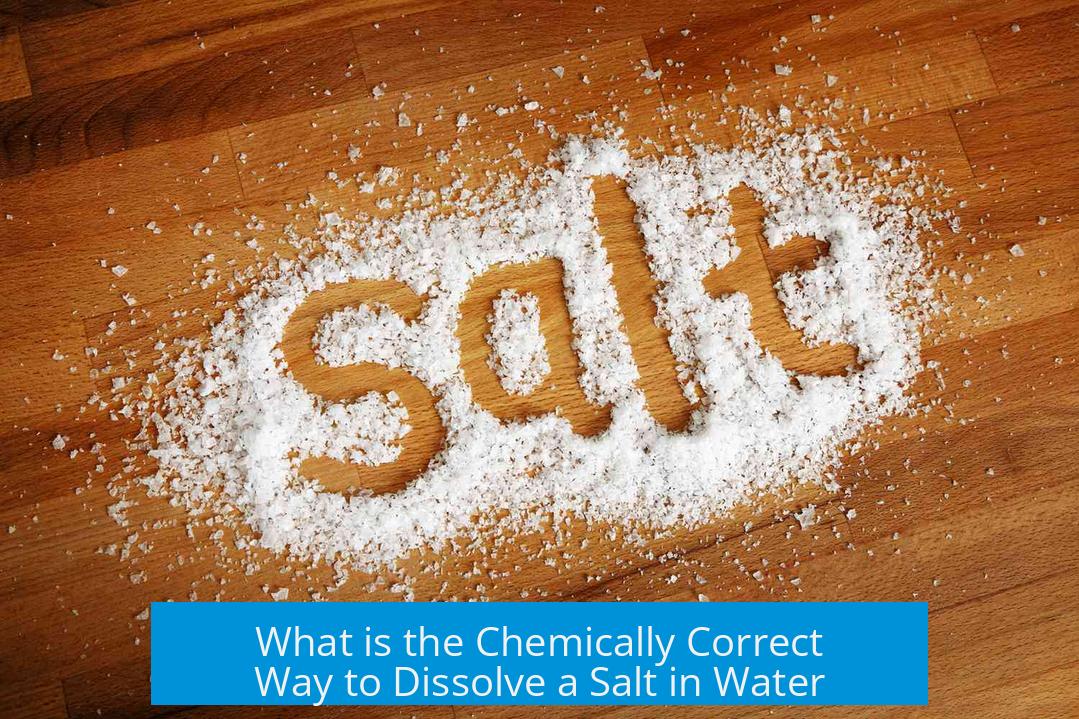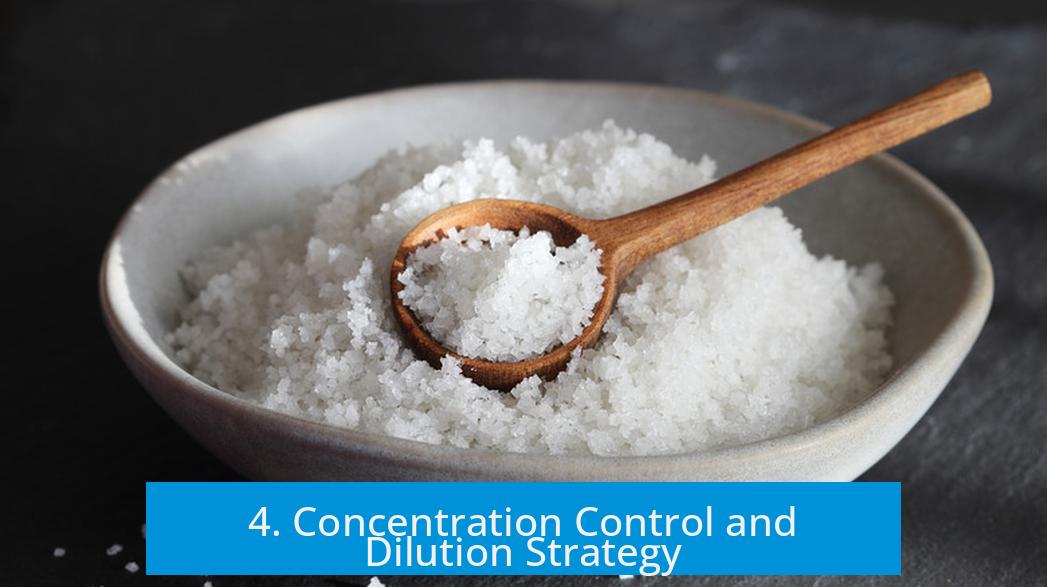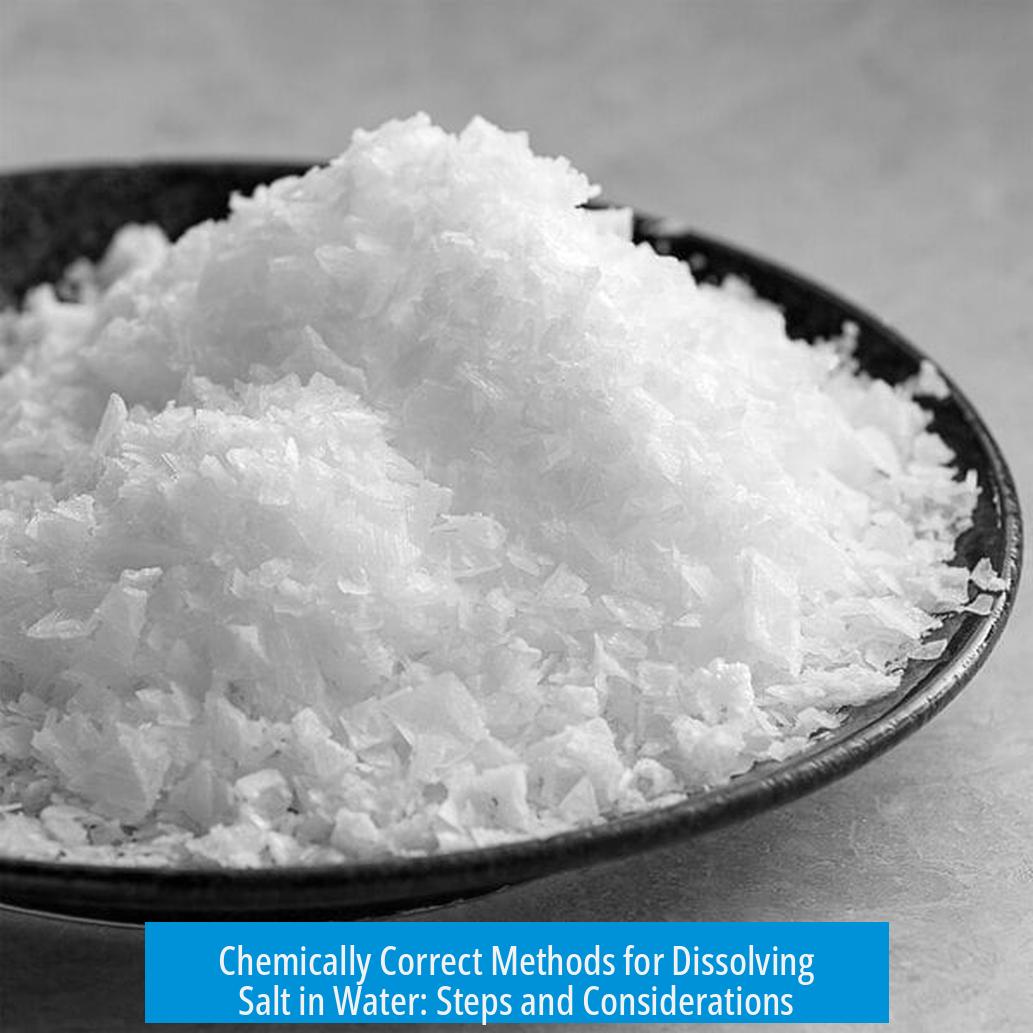What is the Chemically Correct Way to Dissolve a Salt in Water?

The chemically correct way to dissolve a salt in water involves precise weighing of the salt, partial filling of the container with de-ionized water, thorough mixing often aided by stirring or heating, and careful adjustment to a final volume under controlled temperature conditions. This method ensures accurate solute concentration and consistency for analytical or experimental purposes.
1. Preparing the Solution: Steps and Techniques
Begin by selecting a clean, appropriate container such as a volumetric flask or beaker. Use de-ionized water to avoid contamination from extraneous ions.
- Part-fill the container with water, typically less than the final desired volume.
- Weigh the exact amount of salt using a precision balance.
- Transfer the salt into the container. Employ a funnel if needed, rinsing any residual solid on the funnel sides with water to avoid loss.
- Mix thoroughly to dissolve the salt completely. Magnetic stirring bars provide efficient mixing.
- If complete dissolution is slow, gentle heating or swirling can be employed.
- Once dissolved, add water up to the mark representing the final solution volume.
- Mix again to ensure uniform concentration throughout the solution.
2. Importance of Using De-ionized Water
Tap water or non-purified water contains dissolved ions which can interfere with reactions or skew concentration measurements.
De-ionized water reduces risk of contamination. It ensures that only the salt solute contributes ions, maintaining purity and analytical accuracy.
3. Temperature Control During Dissolution
Use water at approximately 25°C (room temperature) to maintain consistent density and reaction conditions.
Dissolution can be endothermic or exothermic, causing temperature fluctuations. Allow the solution to equilibrate to ambient temperature before final volume adjustments.
Maintaining temperature consistency is critical in quantitative work to ensure volumetric accuracy because density and volume vary with temperature.
4. Concentration Control and Dilution Strategy

Accurate concentration demands precise weighing and volume measurement.
Partial dissolution with stepwise additions of water facilitates complete solubility without overshooting volume limits early on.
Once a concentrated stock solution is prepared, aliquots can be diluted to desired concentrations for particular analytical or chemical reactions.
5. Use of Equipment: Magnetic Stirring and Volumetric Flasks
- Magnetic stir bars: Ensure homogeneous mixing and complete salt dissolution.
- Volumetric flasks: Provide precise volume measurements essential for defining solution concentration.
Without effective stirring, undissolved solids may persist, leading to concentration errors.
6. Handling Special Challenges in Salt Dissolution
Some salts pose particular difficulties:
- Hygroscopic salts (e.g., sodium hydroxide) absorb moisture from the air. They gain weight during weighing, causing inaccurate mass measurements. Use desiccators or weigh quickly with minimal air exposure.
- Electrostatic-prone powders scatter and do not transfer cleanly. Use conductive anti-static measures or specialized tools to handle these materials.
Awareness of these issues prevents errors in concentration and ensures reproducible results.
7. Stepwise Detailed Procedure for Dissolution
| Step | Action | Purpose |
|---|---|---|
| 1 | Weigh salt accurately | Precise concentration calculation |
| 2 | Transfer salt to flask via funnel | Prevent loss; ensure complete transfer |
| 3 | Add less water than final volume | Allows complete dissolution in smaller volume |
| 4 | Mix thoroughly (magnetic stir bar/heating) | Dissolve salt fully |
| 5 | Transfer to volumetric flask or graduated cylinder | Prepare for precise volume adjustment |
| 6 | Rinse original container with small water volumes | Recover residual solid, maintain concentration |
| 7 | Fill to final volume mark | Set accurate solution concentration |
| 8 | Mix again | Ensure homogeneity |
8. Summary of Key Considerations
- Use accurately weighed salts and volumetrically precise containers.
- Employ de-ionized water at ~25°C to control density and minimize contaminants.
- Mix thoroughly with magnetic stir bars or heating for complete dissolution.
- Adjust to final volume after dissolution to ensure concentration accuracy.
- Allow temperature equilibration after dissolution to stabilize volume and concentration.
- Be aware of special handling requirements for hygroscopic or static-charged salts.
- Use stepwise dilution from a stock solution to control concentration for analytical needs.
Conclusion
The chemically correct dissolution of a salt in water balances accuracy, purity, and reproducibility. Each step, from weighing through final volume adjustment, aims to control concentration precisely. This protocol supports consistent analytical or preparative chemistry outcomes. Attention to temperature, water quality, and salt properties is essential.
How should salt be added to water to ensure complete and accurate dissolution?
Partially fill the container with water first. Add the weighed salt. Mix until fully dissolved. Then top up to the final volume, washing any residue into the solution during topping up.
Why is it important to use water at around 25°C when dissolving salt?
Water density changes with temperature. Using 25°C water keeps density consistent and matches conditions for later analysis, ensuring accurate concentration and reaction results.
What type of water is recommended for dissolving salt to avoid contamination?
Use de-ionized water. It lacks ions found in tap water that might interfere with analytical results or cause false positives.
Why is a magnetic stir bar recommended during dissolution?
A magnetic stir bar promotes thorough mixing. It helps the salt dissolve completely and evenly, avoiding undissolved particles in the solution.
How can concentration control be maintained when preparing salt solutions?
Dissolve a measured amount of salt in a small volume first. Then dilute stepwise or take aliquots for further dilution. This approach helps maintain accurate and reproducible concentrations.
What challenges might occur with some salts during weighing and dissolution?
Some salts absorb moisture from the air (hygroscopic) or carry static charges, causing handling difficulties. These can affect the measured weight and dissolution process.





Leave a Comment